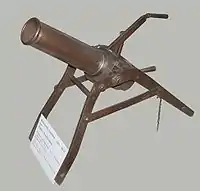9.15 cm leichtes Minenwerfer System Lanz
The 9.15 cm leichtes Minenwerfer System Lanz (Trench mortar) was a light mortar used by Germany and Austria-Hungary in World War I. It was a smooth-bore, breech-loading design that used smokeless propellant. It was chosen by the Austrians as an interim replacement for their 9 cm Minenwerfer M 14, pending development of a superior domestic design, which eventually turned out to be the 9 cm Minenwerfer M 17. The older Austrian design had a prominent firing signature, a less effective bomb and shorter range than the Lanz. Over 500 were ordered with deliveries beginning in April 1917.
| 9.15 cm leichter Minenwerfer System Lanz | |
|---|---|
 | |
| Type | Light trench mortar |
| Place of origin | German Empire |
| Service history | |
| In service | 1914–1918 |
| Used by | German Empire Austria-Hungary |
| Wars | World War I |
| Production history | |
| Designer | Heinrich Lanz |
| Designed | 1914–1915 |
| Produced | 1915–1918 |
| Specifications | |
| Mass | 114 kilograms (251 lb) |
| Barrel length | 595 millimetres (23.4 in) |
| Shell | 3.8 kilograms (8.4 lb) |
| Caliber | 91.5 mm |
| Maximum firing range | 450 metres (490 yd) (M 14/16) |
References
- Ortner, M. Christian. The Austro-Hungarian Artillery From 1867 to 1918: Technology, Organization, and Tactics. Vienna, Verlag Militaria, 2007 ISBN 978-3-902526-13-7
This article is issued from Wikipedia. The text is licensed under Creative Commons - Attribution - Sharealike. Additional terms may apply for the media files.